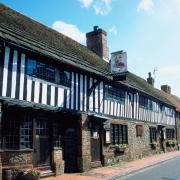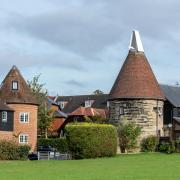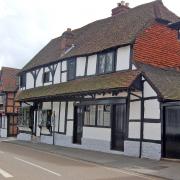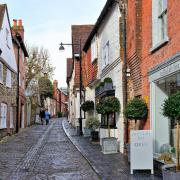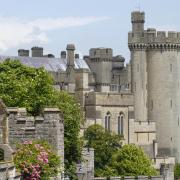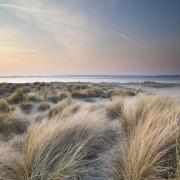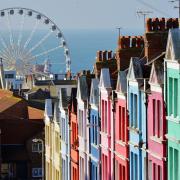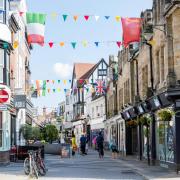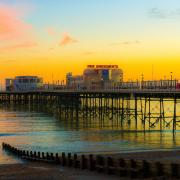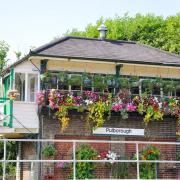Up twitten and down smugglers’ track, Clive Agran discovers there’s much more to Hastings’ history than the famous battle
Those of us who know about these things are, of course, well aware that the world-famous Battle of Hastings didn’t happen in Hastings, which might disappoint those visitors to the town who imagine that Harold and his army were at one end of the seafront while William was at the other and they clashed somewhere around the entrance to the pier.
Although there’s no big battlefield there is plenty of fascinating history in Hastings, particularly in the Old Town. And that’s where I’m meeting Anne Scott of the Old Hastings Preservation Society, who has offered to show me around.
She’s excited, not at meeting me so much as by the award that Hastings Old Town has just received from the Ramblers Association for being The Nation’s Best Walking Neighbourhood. This prestigious accolade has already boosted the numbers who turn up at the top of the West Hill Lift at 2.30pm on Tuesdays for a guided walk that Anne and other OHPS members lead around the Old Town… for free!
The name Hastings derives from Haesta’s people, which is a Danish or Jutish name. The first serious settlement was on the hill above the White Rock. But it’s 1066 and all that which put Hastings on the map. Although the battle took place in, er, Battle.
After landing in Pevensey, Duke William of Normandy marched his men to Hastings where they prepared to tackle Harold, who was on his way south after defeating Harald Hardrada at Stamford Bridge. Following his famous victory, William returned to Hastings where he built the first Norman castle on the West Hill and designated Hastings the capital of the most easterly of the Sussex Rapes.
It was one of the Cinque Ports before huge storms destroyed the harbour in the 13th century and its importance diminished. Things picked up around the middle of the 18th century when the health benefits of the seaside were recognised and the town became more fashionable. Wealthy people settled in what was known as the Bourne Valley, which is where we’ll be walking.
The Bourne is the name of the road that sweeps downhill into the Old Town from the north and Anne explains that beneath it flows the Bourne stream. Covered over in the 20th century to accommodate a road, it used to be the source of the town’s water. Either side of it is a fascinating jumble of houses packed tightly together and perched precariously on the hillside; they seem almost to be jostling with one another. But what makes the Old Town appealing to explore, and possibly clinched the Ramblers’ prize, is the network of twittens (a lovely Sussex word for passages).
Before entering the first of them, we wander along Croft Road, the unmade up part of which is where rope was spun until around 1800. We pause outside an imposing house on the corner, which is where fictional Chief Inspector Foyle lived in the TV series Foyle’s War.
Diagonally opposite is the house in which Sophia Jex-Blake was born and lived. A doctor, teacher and feminist, she led a campaign to secure women access to university education. She and six other women – known as the Edinburgh Seven – blazed the trail by commencing a course in medicine at the University of Edinburgh in 1869. She was the first practising female doctor in Scotland and one of the first in the UK.
At the junction with The Croft we admire three tall houses in Gloucester Place which were built in 1817 and were once considered three of the grandest houses in Hastings. Now mostly converted into flats, they look a little weary. Perhaps that’s what these steep valley sides do to you.
Anne believes the top of East Hill opposite is the furthest westerly spot in England where, when visibility permits, the coast of France can be seen. When a large anticyclone settles over the country, French television and radio invades the area in much the same way as William the Conqueror did more than 950 years ago.
Looking down the High Street, Anne remarks on the extraordinary variety of architectural styles that blend together to create a very pleasing townscape. However, some of the buildings that appear mediaeval aren’t necessarily as old as they look as numerous exposed timbers doesn’t guarantee authenticity, apparently. The area is somewhat prone to mild misrepresentation. For example, Charles Dickens never even stayed the night at ‘Dickens Cottage’. The owner who christened it in the middle of the last century was a friend of the author’s youngest son. Hmm. To redress the balance I should add that a host of genuinely famous people have hung around Hastings including Dante Gabriel Rossetti, John Logie Baird, Screaming Lord Sutch, Edward Lear, Richard D’Oyly Carte, Jo Brand, Catherine Cookson, Simon Fuller, Lewis Carroll, the First Duke of Wellington, Decimus Burton and Paula Yates.
At the top of the High Street is Old Hastings House, which was once the most important and grandest house in town. When it was built around 1700 it was called the Mansion House. Among its illustrious occupants was General James Murray, who was General Wolfe’s second-in-command at the capture of Quebec in 1759. During World War I it was used as a Red Cross Hospital for wounded soldiers.
Over the road where the stables attached to Old Hastings House once stood is the Stables Theatre, which opened in 1959 and constitutes a rare theatrical success in a town where theatres have traditionally struggled.
We pass Torfield House, a 16th century house to which a Georgian frontage has been added, and pause outside Torfield Cottage where, in 1679, Titus Oates, the son of the Rector of the All Saints Church opposite, invented the infamous ‘Popish Plot’ that suggested there was a Catholic conspiracy to murder King Charles II.
We cross over The Bourne where the Bailiff of the Bourne would open a sluice gate once a day to the accompaniment of a bell and flush the lower reaches of the stream.
All Saints Church was completed in 1436 and was occupied by Cromwell’s men during the Civil War. The Royalist rector fled in what was Hastings’ only serious Civil War incident.
Up above the church once stood Hastings House in which Jacob Hemet died in 1790. Not only was Hemet a dentist to royalty but he also patented the first toothpaste. His best-sellers were ‘Essence of Pearl’ and ‘Pearl Dentifrice’.
As we climb a steep and twisting twitten, Anne explains that the 90 degree dog-legs were created by smugglers as an escape aid. Smuggling was big business around here. Also very noticeable is the absence of space between the houses. The gardens were sold off for infill building.
There’s a rather topical aspect to East Hill House on Tackleway, the highest road on East Hill. A plaque reveals Prince Harry’s immediate predecessor as the Duke of Sussex resided here in the summer of 1794 together with his morganatic wife, Lady Augusta Murray, and their infant son. The former Duke of Sussex was the sixth son of King George III but his wife wasn’t allowed to call herself Duchess as the previous Duke’s marriages were in contravention of the Royal Marriages Act of 1772.
After coming back down to sea level, Anne explains one glorious piece of English eccentricity on Winkle Island. The Winkle Club, whose former members include Sir Winston Churchill and Viscount Montgomery of Alamein, is a charitable organisation formed in 1900 by Hastings fishermen to help the under-privileged families of Hastings Old Town. Each Winkle Club member (‘Winkler’) carries a winkle shell which they must produce when challenged to ‘winkle up’. Failure to do so results in a £1 fine which goes towards local charities.








